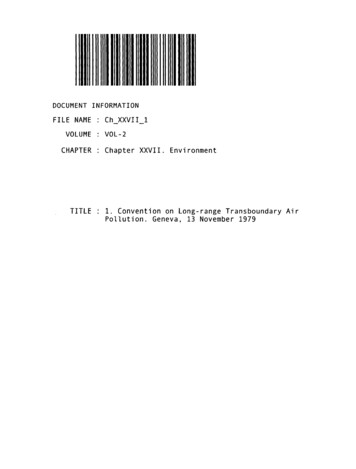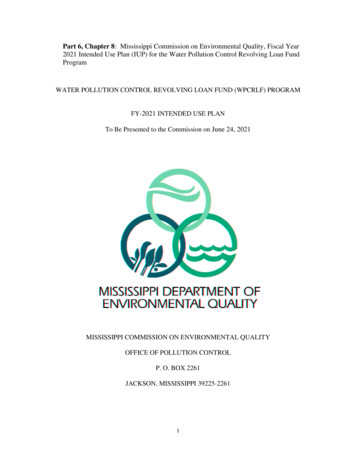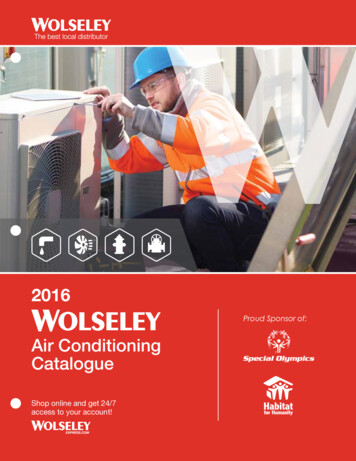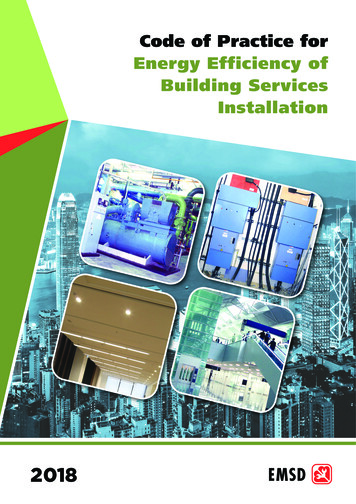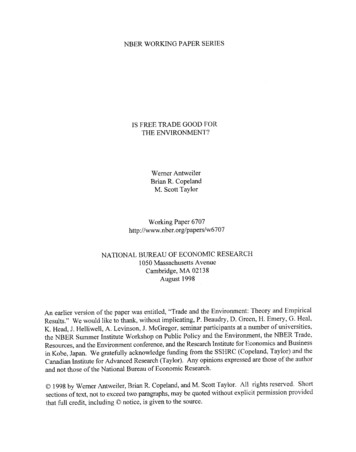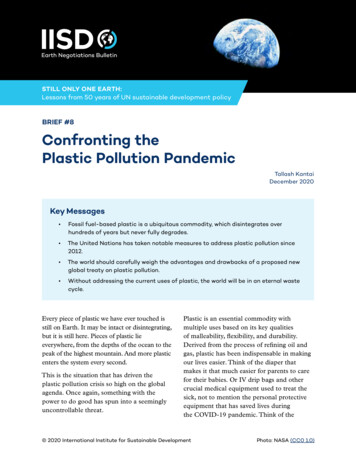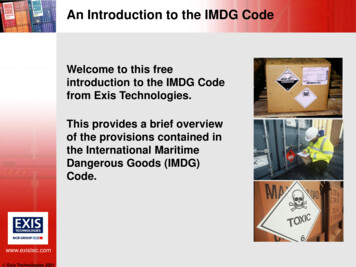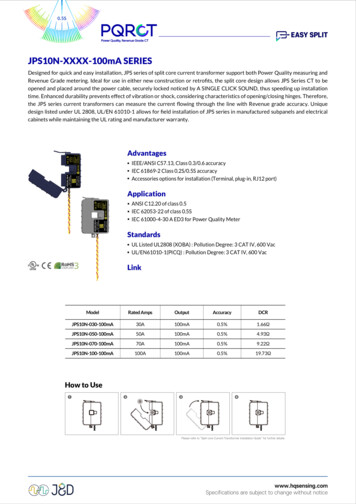
Transcription
To Air Pollution ControlCorrosion Resistant Air Emissions EquipmentPlasticair
Scrubbers
From the Engineers andCraftsmen at Plasticair.Plasticair is a tightly integrated developerand manufacturer of specialized emissioncontrol solutions. Since we were established in 1980, we’ve committed ourselvesto offering a unique combination of engineering excellence and manufacturingcraftsmanship to help our clients solve themost demanding environmental challenges.Technical Excellence.The key to our success is the quality of ourproducts. It begins with the expertise ofour mechanical and chemical engineeringstaff whose patented designs give us theedge in the marketplace. It continues withour selection of state-of-the-art materialsand our strategic relationships with theresearch chemists. But there is more toenvironmental engineering than state-ofthe-art chemistry and precision mechanics; keeping up with regulatory changescan be a full-time job. Our engineers andmanagers are routinely exposed to local,national and global regulations - we keepcurrent. We are always ready to help youengineer an optimal, future-proof, costeffective solution. That is why a partnership with Plasticair is unbeatable.Minds and hands.Within our manufacturing facility ourcommitment to quality is evident in everything we build, from the skilled hands ofour staff, their fabrication experience,methodical assembly skills and dedicationto excellence, to our tight, comprehensiveprocess controls and quality audits. Thisquality is evident in the reliability andeconomy of thousands of units we havedeployed all over the world. At Plasticairour unique combination of engineeringvision, modern manufacturing techniquesand old-fashioned craftsmanship is atyour service.Working Together.We believe in hands on engineering. Ourdesign and manufacturing teams workclosely not just to deliver the best in quality design, but also to do it fast. We canoffer custom design services, short leadtime and rush deliveries, consulting andsupport services to address all your environmental management solutions fromconcept to implementation.TABLE OF CONTENTSIntroduction to Scrubber Technology . . . . . . . . . . . .3Scrubber Selection Guide . . . . . . . . . . . . . . . . . . . . .3Scrubber Fundamentals . . . . . . . . . . . . . . . . . . . . . .4Mass TransferImpingementCoalescingMist Eliminators . . . . . . . . . . . . . . . . . . . . . . . . . . . .5P - Series Mist Eliminators . . . . . . . . . . . . . . . . . . .6Scrubber Bed Packing . . . . . . . . . . . . . . . . . . . . . . .6Crossflow Packed Bed Scrubber . . . . . . . . . . . . . . .7Counter Current Packed Bed Scrubber . . . . . . . . . . .8Odour Scrubbers . . . . . . . . . . . . . . . . . . . . . . . . . . . 9-10Acid Scrubbers . . . . . . . . . . . . . . . . . . . . . . . . . . . . 11-14Venturi Scrubbers . . . . . . . . . . . . . . . . . . . . . . . . . . 15-16Laboratory Fumehood Scrubbers . . . . . . . . . . . . . . . 17-18Automated Systems . . . . . . . . . . . . . . . . . . . . . . . . . 19-20PLC ControlChemical Dosing SystemFRP Industrial Fans . . . . . . . . . . . . . . . . . . . . . . . . . 21-22Page 2
INTRODUCTION TO SCRUBBER TECHNOLOGYIn recent years, greater environmental awareness has meantincreasing regulatory requirements on industry for environmental control andpollution abatement to meet occupational health standards within the plant aswell as meeting community and national air quality standards in the plantvicinity.But there’s more to environmental control than regulatory compliance - the right engineering decisions today can mean increased flexibility inchoosing a greenfield site, a future-proof process that anticipates tomorrow’senvironmental regulations as well as optimized process costs and maximizedprofits. That’s why we at Plasticair advocate a total solution approach, partnering with our customers throughout the design and implementation cycle.We can deliver a range of pollution control solutions that offer: the capacity to meet the most challenging regulatory requirement the performance to meet the toughest operating environments efficiency and reliability to minimize your operating overheads the flexibility to handle future growth in plant capacity innovative design and construction to provide corrosion resistanceand longevity at a price point designed to minimize your total acquisition costsAdditionally, as part of our total solution approach, Plasticair’s engineers can provide consultancy services for situation analyses, system customization, commissioning and start-up support.Wet scrubber technology offers the most powerful, cost-effective range of solutions to industrial airborne pollution challenges. At Plasticairwe’re uniquely qualified to help you design and implement emission control solutions. We’ve been designing, manufacturing and deploying this technology worldwide since 1980. Our experienced staff is ready to supply fully automated scrubber systems complete with fans, fully programmed PLCcontrol panels and chemical dosing systems offering contaminant removal efficiencies of up to 99.9% on particles as small as one micron.This bulletin explains how scrubber technology works and introduces Plasticair’s complete line of scrubber technology solutions.The Plasticair ScrubberSelection GuideHCS SeriesHorizontal Packed BedVCS SeriesVertical Packed TowerHS SeriesHorizontal Packed BedVS SeriesVertical Packed TowerECE SeriesHorizontal VenturiFHS SeriesCounter Current FumehoodE SeriesMulti Stage Mist EliminatorP SeriesMist lesstDuand n)ticParrAdo )Aci icronlinlkaeMistrAid oAc on)il crom Mvy Micrdiu -30e O MiFinUp to 11MeFrom 12HeOaver 30(((lkealinMisteavto H lesmdiu rticMe st PaDuil,yOdt anMisRECOMMENDED RNOT RECOMMENDED NRSUMMARYRRRNRRRNRBEST SUITED FOR HIGH EFFICIENCY REMOVAL OF HYDROGENSULPHIDE, MERCAPTANS, ALDEHYDES WHEN A HORIZONTALAPPLICATION IS REQUIRED.RRRNRRRNRBEST SUITED FOR HIGH EFFICIENCY REMOVAL OF HYDROGENSULPHIDE, MERCAPTANS, ALDEHYDES WHEN A VERTICALAPPLICATION IS REQUIRED.NRRRNRRRNRBEST SUITED FOR HIGH EFFICIENCY REMOVAL OFINORGANIC/ORGANIC ACID MIST AND OR ACID GAS WHEN AHORIZONTAL APPLICATION IS REQUIRED.NRRRNRRRNRBEST SUITED FOR HIGH EFFICIENCY REMOVAL OFINORGANIC/ORGANIC ACID MIST AND OR ACID GAS WHEN AVERTICAL APPLICATION IS REQUIRED.NRNRRRRRRBEST SUITED FOR HIGH EFFICIENCY PARTICULATE REMOVAL MOSTCOMMONLY USED FOR GAS STREAMS CONTAINING OIL OR DUST.NRRRNRRRNRDESIGNED SPECIFICALLY FOR LABORATORY INORGANIC ACIDAND PECHLORIC ACID EXHAUST.NRRRRRRRECONOMICAL MULTI PURPOSE SCRUBBERS. CAN BE UTILIZEDFOR ACID MIST, ACID GAS AND CHROME.NRNRNRNRRRRMIST ELIMINATOR SUITIBLE FOR ANY REMOVAL OF 12 MICRONPARTICLES OR LARGER.Page 3
FUNDAMENTALSMass TransferMass transfer is the chemical process by which scrubber unitsabsorb contaminated gas molecules, sub-micron mists and particulatesinto a scrubbing liquid. This fundamental process is independent of thescrubber unit’s configuration or orientation.At its simplest, mass transfer involves a contaminated airstream moving through a mixing chamber. A liquid sprayed into thischamber mixes with the air stream. Contaminated gas molecules are dissolved by contacting with the sprayed liquid and are removed from the airstream. The process relies on the natural affinity, or attraction, of the conABSORPTION (MASS TRANSFER)taminant molecules to the scrubbing solvent which may be plant water orinvolve the addition of chemical solvents to improve the absorption of certain chemical contaminants.The efficiency of the mass transfer process is enhanced by introducing packing media into the mixing chamber to create turbulence within the air stream, forcing the molecules of the scrubbing liquid and the contaminants into intimate contact. Efficiency may be further enhanced byionizing the air stream.Scrubbing technology, using the mass transfer process, is the most cost effective pollution control solution for sub-micron gaseous contaminants at velocities below 2.5 m/sec (500 fpm) particularly where the contaminant concentration is low.ImpingementImpingement refers to the simple mechanical process of forcingmolecular collisions between scrubbing liquids, particulates or mists. Thesecollisions may be either between molecules and fixed media or among themolecules themselves. Typically the fixed media are packing, mesh, profile blades or rods.Impingement is most effective when used with air stream velocities greater than 7.5 m/sec (1500 fpm).IMPINGEMENTCoalescingThis is a cost effective mechanical process for removing mists orentrained liquid by forcing small liquid drops to coalesce or combine tobecome larger drops. This is accomplished by introducing a coalescing padinto the air stream as part of a vertical or horizontal system implementation. Upon exiting the coalescer unit, the coalesced liquid is removed fromthe contaminated air stream by means of a mist eliminator. This process iseffective at high gas velocities, typically of 5.08 m/sec (1000 fpm) orhigher.Page 4COALESCING
MIST ELIMINATORSPlasticair’s P series vane module mist eliminator is an impingement separator unit consisting of an FRP shell, FRP transitions, CPVC spraysfor periodical wash-down, a drain and two removable PVC Vane Bank modules.Detail on Next PageVane BanksPlasticair’s proprietary Vane Bank Module is fabricated by us using ourpatented PVC extruded vane blade design. The vane blades are assembled into aremovable frame unit for easy inspection and maintenance. Vane bank units incorporate a standard spacing of 16 mm (0.625”) between blades and can be operated vertically or horizontally. These vane banks may be incorporated with variousPlasticair scrubber units as part of a comprehensive elimination solution or may beused in a stand-alone mode as an effective particle and mist removal unit.Plasticair high efficiency vane bank units are capable of achievingremoval rates of up to 99% of particulate contaminants of 12 microns or larger.They operate at an effective velocity range of 1.5 M/sec (300 fpm) to 10.16 M/sec(2000 fpm).VANE BANK DETAILVANE BLADE DETAILMesh-Type Mist EliminatorsHigh Density PackingPlasticair’s mesh mist eliminatorsHigh density packing has between 2 and 3 times more surfaceare high efficiency collection units ideallyarea per volumetric unit than standard packing media and may be used assuited for small liquid particle collection.Mesh mist eliminators are suitable for airstream velocities of less than 3.048 M/sec(600 fpm). Mesh-type units should be useda mist eliminator for air stream velocities of approximately 2.4 M/sec(480 fpm). High density packing results in a much higher pressure dropper unit of packed bed length because of the increased surface area.Plasticair’s standard mist eliminator using high density packingincorporates a 305-914 mm (12-36”) bed length. This type of mist elimi-for mist elimination solutions with lownator achieves a standard efficiency of 99% removal for particles of 10exposure to particulates to avoid clogging.microns or larger.Page 5
P-SERIESWIDTHLENGTHMISTELIMINATORTWO STAGEINLET AL DIMENSIONS ONLY. INTERMEDIATE SIZES ARE NOT LISTED IN THIS BULLETIN.SCRUBBER BED PACKINGA packing medium is usually introduced into the mixing chamber to increase both impingement and mass transfer processes within a scrubber unit. Referred to as scrubber bed packing, this material is designed for maximum surface area, with minimal air stream impedance and, consequently, the least possible pressure drop within the mixing chamber. This packing material maximizes the wetted-surface contact between the contaminated air stream and the applied scrubber liquid. By minimizing the pressure drop within the chamber, the packing material minimizes powerrequirements, energy consumption and operating costs. Polypropylene is typically used as a packing medium although certain applications mayrequire PVC, PVDF, ceramic or polyethylene based scrubber beds.VERTICAL WATER FLOWVERTICAL WATER FLOWHORIZONTAL WATER FLOWCROSSFLOW SCRUBBER FORMATCO-CURRENT SCRUBBER FORMATPage 6COUNTERFLOW SCRUBBER FORMAT
OPERATING FUNDAMENTALS - CROSSFLOW PACKED BED SCRUBBERCrossflow Packed Bed Scrubbers are used in environmental control applications which require contaminant gas absorption with or withoutparticle removal. The process involves a scrubbing liquid flowing vertically through the scrubber mixing chamber perpendicular to the contaminatedair stream. The mixing chamber contains packing material which maximizes contact between the two streams, facilitating contaminant absorption ofthe scrubbing liquid before falling into the sump below.Plasticair’s HCS/HS Series Crossflow Scrubbers are used for gaseous and particulate contaminant removal as well as for odour control applications. Plasticair scrubbers incorporate a unique WAVEWALL construction which offers greater structural integrity of the scrubber unit than traditional straight wall construction. More importantly, this construction enhances operating efficiency by forcing packing material into the patented wallcrevices, maximizing contact and reducing negative wall effects. This increased efficiency is particularly evident when dealing with low volume airflows.MIST ELIMINATORSPRAY SYSTEMCONTAMINATEDGAS INLETCLEAN GASOUTLETMIXINGCHAMBERSUMPLIQUIDFor applications involving complex contaminants in a noxious gas stream, Plasticair offerscrossflow scrubber configurations with multiple packing bed sections, each designed to capture a particular contaminant. The chemical dosing process of eachbed is isolated by incorporating a separate mist eliminator and sump within each section.Plasticair also offers crossflow scrubberconfigurations incorporating an ionizing section,manufactured from 316 stainless steel, to moreeffectively eliminate sub-micron and non-polar particulates by charging arriving contaminant moleculesbefore they enter the packed bed sections. Thecharged particles are attracted to the wetted packingmedia, greatly increasing absorption and removal.Negative WallEffectsNegative WallEffectsNegative WallEffectsWavewallPage 7Conventional Straightwall
OPERATING FUNDAMENTALS - COUNTER CURRENT PACKED BED SCRUBBERCounter current packed bed scrubbers involve a downwardCLEAN GASOUTLETflowing liquid, either plant water or chemical solvent, impinging uponan upward flowing contaminated air stream. Contaminants areabsorbed by the scrubbing liquid which collects in the sump. This typeof scrubber is used to achieve gas absorption, with or without particleremoval, using the principle of mass transfer. Once again, packingmaterial is used to maximize the wetted surface contact between theopposing streams.MISTELIMINATORAs with crossflow scrubbers, Plasticair can customize thenumber of beds or modify the bed length to meet the contaminant orSPRAY SYSTEMefficiency objectives of any application. Note that unlike crossflowscrubber implementations, a multiple bed counter current scrubberrequires a separate vessel for each bed section to avoid any carry overbetween sections. High density random packing, often in conjunctionMIXING CHAMBERwith mesh pads may be configured to further prevent mist carry over.PVC vane-type mist eliminators are most commonly used in Plasticaircounter current applications.CONTAMINATEDGAS INLETComparing Cross Flow andCounter Current Scrubber ApplicationsLIQUIDMaintenance:Because the liquid and gas streams in crossflow scrubber applicationsdo not directly impinge upon each other, this design is less susceptibleto clogging.Cost:Crossflow scrubbers use less liquid than comparable counter current scrubbers thus requiring less pump capacity. The pressure drop in vertical countercurrent scrubbers is slightly higher than in cross flow scrubbers because of the opposing gas and liquid streams. Consequently, cross flow scrubberenergy consumption costs are lower than for comparable counter current models.Space Constraints:Horizontal scrubbers are ideal for height-restricted installations where height is limited. The height and width of Plasticair’s HCS/HS series scrubberscan be customized to accommodate most scrubber service rooms. Counter current scrubbers are ideal for applications where floor space is limited andheight is unrestricted.Page 8
A TOTAL SOLUTION APPROACH TO ODOUR CONTROLWe continue to see increasingly stringent regulations to abate industrial odours in many sectors from agricultural facilities to industrial usersof chemical processes to municipal waste treatment facilities.Plasticair offers a wide range of vertical and horizontal odour scrubbers designed to meet a wide range of performance objectives, processchemistries, operating budgets and physical constraints.In addition, Plasticair’s engineers can provide consultancy services for situation analyses and evaluations, customized system design, commissioning and start-up support.Horizontal Odour Scrubbers The Plasticair HCS SeriesVertical Odour Scrubbers The Plasticair VCS SeriesThe Plasticair HCS series of crossflow scrubbers aredesigned to provide high efficiency odour control in environmentswhere height is a major constraint. The HCS design allows boththe height and the width of the unit to be customized to accommodate restrictive scrubber mechanical rooms. The HCS series cansupport air volumes from 236 l/sec (500 cfm) up to 47,2001/sec (100,000 cfm) and can achieve gas absorption efficienciesof up to 99.9%.Plasticair’s HCS series exemplifies the Company’s commitment to leading-edge design and state-of-the-art materialsselection. Each unit is built with a solid Fibre Reinforced Plastic(FRP) scrubber shell for maximum corrosion resistance, structural integrity and longevity which is further enhanced by Plasticair’sunique WAVEWALL design for improved efficiency and structural integrity. Internal components utilize a combination ofPolypropylene, PVC, CPVC and Fiberglass. Multiple units may beconfigured in series to further improve efficiency and to supportseveral scrubbing liquids for complex odour control situations.The Plasticair VCS series of counter current scrubbersprovide ideal odour control in locations with limited floor spacebut without height restrictions. The VCS series can support air volumes ranging from 236 1/sec (500 cfm) up to 35,400 1/sec(75,000 cfm)while achieving gas absorption efficiencies of up to99.9%.Like their HCS series counterparts, Plasticair’s VCSseries units are built with a solid Fibre Reinforced Plastic (FRP)scrubber shell and internal components of Polypropylene, PVC,CPVC and Fiberglass Reinforced Plastic (FRP).In standard configuration, HCS/VCS series units are supplied with a 2438 mm (8’ 0”) packed bed for maximum absorption efficiency. Theseunits can be configured with optional integral pumps, PLC Control Panels and secondary containment systems. In addition, Plasticair can provide custom HCS/VCS series configurations based on the individual process application or gas absorption efficiency objectives. Custom configurations mayinvolve changes to any of the following HCS/VCS series design parameters: packed bed lengthwater volumechemical dosing volumedosing system chemicals selectionair velocityuse of ionization section(s)use of flushing section(s)choice of premium quality vinyl ester or polyester resins for scrubber shellchoice of alternative thermoplastics and resins for internal componentsPage 9
HCS-SERIESLENGTHWIDTHHEIGHTGENERAL DIMENSIONS ONLY. INTERMEDIATE SIZES ARE NOT LISTED IN THIS BULLETIN.VCS-SERIESDIAMETERHEIGHTLENGTHPage 10GENERAL DIMENSIONS ONLY. INTERMEDIATE SIZES ARE NOT LISTED IN THIS BULLETIN.
SOLUTIONS FOR ACIDIC EMISSION MANAGEMENTIn addition to traditional applications such as plating, metal processing and battery manufacturing, the industrial use of acidbased etching processes have increased significantly in recent years particularly in the electronics sector. Etching and plating process designrequires stringent management of acidic emissions for clean air and workplace safety regulatory compliance. In addition, tight control ofairborne acidic contaminants can prevent plant and process equipment from premature deterioration through corrosion.For over fifteen years, a broad spectrum of industrial sectors have relied upon Plasticair to meet their acidic emission controlneeds. To address wide ranging process applications as well as a diversity of global emission control standards, Plasticair has developeda series of four highly efficient acid scrubber models which can flexibly and economically meet the toughest emission management challenges. These scrubber units may be custom configured to offer a range of elimination efficiencies from 60% using spray chambers andmist eliminators to 99.9% using packed beds.Horizontal Acid ScrubbersVertical Acid ScrubbersPlasticair’s HS series of horizontal acidscrubbers incorporates a high efficiency crossflowdesign ideally suited for elimination of both acidic andalkaline mists. These designs can be configured toeliminate corrosive particulates generally by incorporating a spray unit at the front face of the packedbed. This provides a flushing action which reducesclogging and maintenance overhead. Please refer tothe introduction to scrubbing technology at the beginning of the document for a more detailed explanationof crossflow scrubber operating principles.The HS series may be configured to supportgas volumes ranging from 236 l/sec (500 CFM) up to47,200 l/sec (100,000 CFM) with efficiencies of up to99.9%.The Plasticair VS series of vertical acidscrubbers use the counter current process, asdescribed in the introduction to scrubbing technologyat the beginning of this document, to provide highefficiency elimination of corrosive mists and particulates, both acidic and alkaline. This range of scrubberunits can be configured to handle a range of gas volumes from 236 l/sec (500 CFM) up to 35400 l/sec(75,000 CFM) at up to 99.9% contaminant elimination efficiency.In standard configuration, the HS and VS series of acid scrubbers incorporate a 1524 mm (60”) packed bed. The optimum bedlength is application specific and Plasticair’s designers can extend or reduce the standard dimensions to accommodate specific contaminants or removal efficiency objectives.Page 11
HS-SERIESLENGTHWIDTHHEIGHTGENERAL DIMENSIONS ONLY. INTERMEDIATE SIZES ARE NOT LISTED IN THIS BULLETIN.VS-SERIESDIAMETERHEIGHTLENGTHPage 12GENERAL DIMENSIONS ONLY. INTERMEDIATE SIZES ARE NOT LISTED IN THIS BULLETIN.
OPTIMIZING ACID SCRUBBER EFFICIENCYThe following examples illustrate the versatility of standard designs in addressing a wide range of process challenges. The first case studyinvolves a Nitric Acid elimination scenario.Removal Efficiency ObjectiveContaminantSolutionLength of packed bedBed materialChemical dosingpH LevelAir velocity (through packing)99.9%HN033048 mm (120”)PolypropyleneNaOH92.2 m/sec (450 fpm)The scrubbing liquid is dosed with the neutralizing agent (NaOH, Sodium Hydroxide) in the scrubber unit’s recirculation system. The recirculated liquid is sprayed into the packed bed, absorbing the oncoming nitric acid mist and neutralizing the corrosive emission. Because of the unusually high efficiency objective in this case, Plasticair’s engineers solved the problem by extending the bed length to provide a sufficient neutralizationinterval.In a more complex case study, an acid scrubber is used for removal of an NOX contaminant stream containing HN03 (Nitric Acid), NO (NitricOxide) and N02 (Nitrogen Dioxide). For cost effectiveness, a counter current scrubber is ideally suited to this application and Plasticair’s approach toNOX removal normally involves a three stage counter current packed bed implementation. The first stage converts NO to NO2 through oxidation. Thesecond stage reduces the concentration of HNO3 and NO2. Finally, the third stage is used for odour removal. This system typically will have an airstream velocity of 1.5 m/sec (300 fpm) and achieve a 99% removal efficiency.Typical NOx SolutionClean GasNitric Acid, Nitric Oxide,Nitrogen DioxideFRP Exhaust FanStage 3Odour ControlStage 2ReductionPage 13Stage 1ConversionAcidicProcess
ACIDIC EMISSION MANAGEMENT WITH MULTI STAGE MIST ELIMINATORSE-SeriesThe E series of scrubber units from Plasticair offers an extremely cost effective, low maintenance set of mist elimination solutions. Theseunits are used in a variety of corrosive control applications, most commonly in the metal finishing industry. In plating applications, E series scrubbersmay be used for chrome particulates down to 1 micron in size. The most common configurations incorporate a combination of internal sprays and misteliminators in conjunction with a coalescer unit. Packed beds are not normally included in these designs.Stringent design and materials selection contribute to the efficiency and cost effectiveness of Plasticair’s multi-stage mist eliminators. E seriesunits are built upon a solid FRP scrubber shell and employ CPVC sprays and piping. Mist elimination sections, operating on the principle of mechanical impingement, use a PVC vane stage incorporating Plasticair’s patented, high-efficiency vane design. The coalescer stage utilizes a polypropylenecoalescer pad. The E series offers significant configuration flexibility and Plasticair can offer custom designs and material selections for a wide rangeof applications.E Series configurations support gas volumes of between 94.4 1/sec (200 cfm) and 28320 1/sec (60000 cfm). In gaseous contaminantapplications, 80% removal efficiency may be achieved with velocities of 2.286 m/sec (450 ft/min). For solid contaminants, 99% removal efficiencyof 3 micron, or larger, particulates is achievable using air stream velocities up to 10.16 m/sec (2000 ft/min.).LENGTHMIST ELIMINATORSINGLE STAGECOALESCERDEPTH VARIABLEMIST ELIMINATORSINGLE STAGEINLETHEIGHTSPRAYSSPRAYSDRAINDRAINGENERAL DIMENSIONS ONLY. INTERMEDIATE SIZES ARE NOT LISTED IN THIS BULLETIN.Page 14
VENTURI SCRUBBERSThe Plasticair ECE series of venturi scrubbers are ideal for fine particle collection. These horizontal non-clogging units operate on theimpingement principle and are capable of collecting 99% of particles 1 micron or larger. ECE Series units operate at air flow velocities ranging fromas low as 94.4 l/sec (200 cfm) to 33040 1/sec (70,000 cfm) at up to 2484 Pa (10.0” W.G.) pressure drop. Custom designed vertical units are alsoavailable.In addition to the ECE series, Plasticair also offers an economical series of mini-venturi scrubbers suitable for very low volume applications.Venturi Scrubber OperationA contaminated air stream entering the scrubber inlet is immediately drawn into the venturi section, where molecular impingement occurs.A scrubbing liquid sprayed directly into the venturi section impinges upon the gaseous contaminant. This scrubbing liquid usually contains a chemicaldosing agent to neutralize and dissolve contaminant particles. The air stream is accelerated significantly within the venturi section with velocities ranging from between 20.3’ m/sec (4000 ft/min) to as much as 45.72 m/sec (9000 ft/min) depending on the removal efficiency objectives.ECE series units can provide low maintenance particulateVENTURI SECTION DETAILelimination solutions to meet thetoughest challenges. Plasticair’s venturi scrubber design incorporatesknock-down baffles, located directlyINLETbehind the venturi section, whichsignificantly eliminates liquidentrainment from the air stream.This prevents over-loading in theunit’s mist elimination section byreducing vane bank clogging.Stringent materials selection is critical to the quality androbustness of ECE series venturiscrubbers. All units incorporate, asstandard, a solid FRP scrubber andventuri shell, internal componentsconstructed from FRP, PVC or CPVCPOINT OF IMPINGEMENTand standard recirculation pumpsconstructed from CPVC.Plasticair can supply customized ECE series-based solutions including fully programmed PLC control panels ready for standalone automation or ready for integration with existing process designs. Customized designs for piping and chemical dosing systems, integral sumps and pumps,vane bank wash-down units and optional solid fiberglass industrial exhaust fans are a Plasticair specialty. In addition to custom solution engineeringand fabrication, we also offer system start-up support and commissioning services as part of our commitment to offering total environment controlsolutions.Page 15
ECE-SERIESSTANDARD FEATURES AND OPTIONS1. Adjustable Venturi Section2. Chemical Sampling Housing3. PH/ORP Control Panel4. Liquid Recirculation System5. Mist Elimination Section6. Clean Air Outlet (Round or Rectangular)7. Dirty Air Inlet (Round or Rectangular)8. Mixing Chamber9. Chemical Injection PipingLENGTHWIDTHHEIGHTECE-Series DimensionsGENERAL DIMENSIONS ONLY. INTERMEDIATE SIZES ARE NOT LISTED IN THIS BULLETIN.Page 16
LABORATORY FUMEHOOD SCRUBBERSPlasticair’s FHS series of fumehood scrubbers, ideal for elimination of acidic emissions, offers a unique solution to laboratory emission management. The patented design of the FHS series offers major advantages over traditional solutions including reduced installation cost reduced maintenance cost longer operating life high quality industrial design in a compact integrated unitwhile meeting the most stringent air emission standards.The FHS series integrates a counter current scrubber with a traditional fumehood design to reduce space requirements, eliminate the needfor a remote scrubber and significantly reduce installation and maintenance costs. The standard FHS series unit is capable of removing 96% of acidiccontaminants up to 500 PPM. These units, originally designed for perchloric acid elimination, are effective in controlling the complete spectrum ofindustrial inorganic acids including Hydrochloric, Hydrofluoric, Sulphuric and Nitric
ship with Plasticair is unbeatable. Minds and hands. Within our manufacturing facility our commitment to quality is evident in every-thing we build, from the skilled hands of our staff, their fabrication experience, methodical assembly skills and dedication to excellence, to our tight
